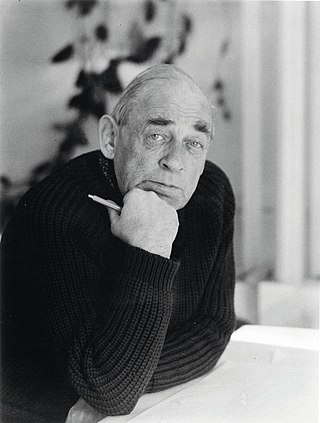
Hugo Alvar Henrik Aalto was a Finnish architect and designer. His work includes architecture, furniture, textiles and glassware, as well as sculptures and paintings. He never regarded himself as an artist, seeing painting and sculpture as "branches of the tree whose trunk is architecture." Aalto's early career ran in parallel with the rapid economic growth and industrialization of Finland during the first half of the 20th century. Many of his clients were industrialists, among them the Ahlström-Gullichsen family, who became his patrons. The span of his career, from the 1920s to the 1970s, is reflected in the styles of his work, ranging from Nordic Classicism of the early work, to a rational International Style Modernism during the 1930s to a more organic modernist style from the 1940s onwards.
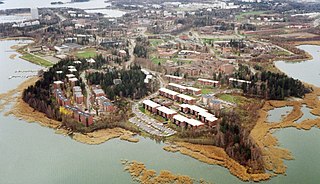
Otaniemi (Finnish), or Otnäs (Swedish), is a district of Espoo, Finland. It is located near the border of Helsinki, the capital of Finland.

Helsinki University of Technology was a technical university in Finland. It was located in Otaniemi, Espoo in the metropolitan area of Greater Helsinki. The university was founded in 1849 by Grand Duke of Finland, Emperor Nicholas I and received university status in 1908. It moved from Helsinki to Otaniemi campus area in 1966. It was merged into Aalto University in 2010 and briefly had the name Aalto University School of Science and Technology before being split into four schools in 2011.

Stockmann plc is a Finnish retailer established in 1862.
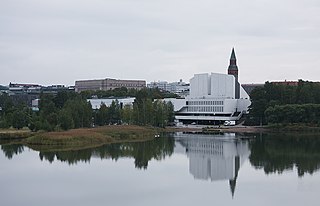
The Finlandia Hall is a congress and event venue in the centre of Helsinki on the Töölönlahti Bay, owned by the City of Helsinki. The building, which was designed by architect Alvar Aalto, was completed in 1971. Every detail in the building is designed by Aalto. The designs were completed in 1962, with building taking place between 1967 and 1971. The Congress Wing was designed in 1970 and built in 1973–1975. In 2011, the building was expanded with new exhibition and meeting facilities. Finlandia Hall is known as the venue for the OSCE Summit held in August 1975, attended by 35 world leaders, including the leader of the Soviet Union, Leonid Brezhnev, and the President of the United States, Gerald Ford.

Aino Maria Marsio-Aalto was a Finnish architect and a pioneer of Scandinavian design. She is known as a co-founder of the design company Artek and as a collaborator on its most well-known designs. As Artek's first artistic director, her creative output spanned textiles, lamps, glassware, and buildings. It has been discovered that it was Aino who completed the first work commissioned through Artek which was the Viipuri Library in 1935. Her work is in the permanent collection of the Museum of Modern Art (MoMA) in New York,and the MoMA has included her work in nine exhibitions. Aino Aalto’s first exhibition was Art in Progress: 15th Anniversary Exhibitions: Design for Use at MoMA in 1944. Other major exhibitions were at the Barbican Art Gallery in London and Chelsea Space in London. Aino Aalto has been exhibited with Pablo Picasso.

Artek is a Finnish furniture company. It was founded in December 1935 by architect Alvar Aalto and his wife Aino Aalto, visual arts promoter Maire Gullichsen and art historian Nils-Gustav Hahl. The founders chose a non-Finnish name: the neologism Artek was meant to manifest the desire to combine art and technology. This echoed a main idea of the International Style movement, especially the Bauhaus, to emphasize the technical expertise in production and quality of materials, instead of historical-based, eclectic or frivolous ornamentation.

Erik William Bryggman was a Finnish architect. He was born in Turku, the youngest of the five sons of Johan Ulrik Bryggman (1838–1911) and Wendla Gustava Bryggman (1852–1903). He began studies in architecture at Helsinki University of Technology in 1910 and qualifying as an architect in 1916. In 1914 he and fellow student Hilding Ekelund made a study trip to Denmark and Sweden. In 1920 he travelled to Italy, where he became inspired more by the local vernacular architecture than the classical or Baroque works. He worked in Helsinki for various architects, including Sigurd Frosterus, Armas Lindgren, Otto-Iivari Meurman and Valter Jung before starting his own office in Turku in 1923. Bryggman's architecture is noted for its combination of Nordic, classical and modernist characteristics.
Kristian Valter Alexander Gullichsen was a Finnish architect. The son of Harry and Maire Gullichsen, he was born into a family of industrialists, designers and artists. His siblings were the renowned Finnish philosopher Lilli Alanen and Johan Gullichsen, a professor of engineering. Kristian Gullichsen had three sons and two daughters, one of the sons was the artist Alvar Gullichsen. Gullichsen was married twice; his second wife was architect Kirsi Gullichsen.

Stockmann Helsinki Centre is a culturally significant business building and department store located in the centre of Helsinki, Finland. It is one of many department stores owned by the Stockmann corporation. It is the largest department store in the Nordic countries in terms of area and total sales. The store is known for carrying all the internationally recognised luxury brands, and Stockmann's enjoys a reputation as the primary high-end department store in Finland. Stockmann Delicatessen, the food and beverage department located at the basement level, is renowned for the quality and choice of its foodstuffs. The Stockmann logo represents a set of escalators, which are commonly, but wrongly believed represent the first escalators in Finland. The first escalators in Finland were installed in the Forum department store, Turku (1926).
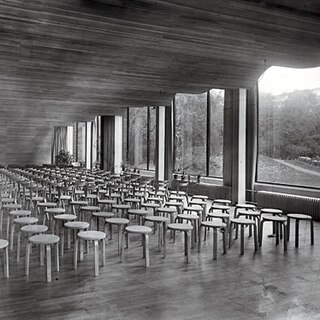
The architecture of Finland has a history spanning over 800 years, and while up until the modern era the architecture was strongly influenced by currents from Finland's two respective neighbouring ruling nations Sweden and Russia, from the early 19th century onwards influences came directly from further afield: first when itinerant foreign architects took up positions in the country and then when the Finnish architect profession became established.

Aalto University is a public research university located in Espoo, Finland. It was established in 2010 as a merger of three major Finnish universities: the Helsinki University of Technology, the Helsinki School of Economics and the University of Art and Design Helsinki. The close collaboration between the scientific, business and arts communities is intended to foster multi-disciplinary education and research.

Kulttuuritalo is a building in Alppila, Helsinki, Finland. The building was designed by Alvar Aalto, and is considered to be one of his main works.
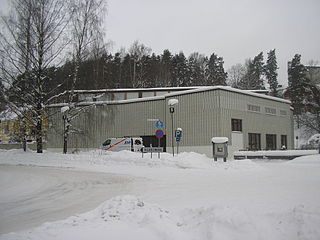
The Alvar Aalto Museum is a Finnish museum operating in two cities, Jyväskylä and Helsinki, in two locations each, dedicated to architect and designer Alvar Aalto. All four locations are open to the public. They are:
The Academic Bookstore is a Finnish chain of bookstores. It has both physical outlets as well as an online presence.
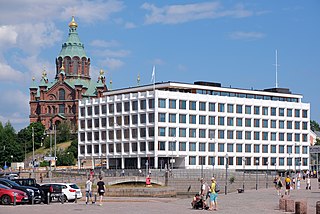
The Stora Enso headquarters is an office building located in the Katajanokka neighbourhood of central Helsinki, Finland, completed in 1962. It is notable for having been designed by the Finnish architect Alvar Aalto.

Rautatalo is an office building in central Helsinki, Finland, completed in 1955, and notable for having been designed by the Finnish architect Alvar Aalto.

Villa Tammekann is a residential building located in Tartu, Estonia, notable for being one of few private residences designed by the Finnish architect Alvar Aalto, his first design to be realised outside Finland, and the only one located in Estonia or anywhere in the Baltic states.

Keskuskatu, literally 'Central Street', is a two block-long pedestrian street in the centrally-located Kluuvi neighborhood of Helsinki, Finland. Along the street are located : the Stockmann department store, the Rautatalo building, Domus Litonii, the World Trade Center and the Citycenter Mall, nicknamed "Makkaratalo". Keskuskatu begins at Pohjoisesplanadi, across from the Swedish Theatre, and ends when it meets Kaivokatu, across from Helsinki Central Station. It is intersected just south of its midpoint by Aleksanterinkatu.

The Edgar J. Kaufmann Conference Center is a conference hall on the 12th floor of 809 United Nations Plaza in the Turtle Bay neighborhood of Manhattan in New York City. Designed by Finnish architect Alvar Aalto for professor Edgar Kaufmann Jr., it is one of four remaining designs by Aalto in the United States. The conference center was announced in 1962, during the construction of the Institute of International Education (IIE)'s headquarters, and was dedicated in December 1964. After the building was sold in 1998 to a group backed by Japanese financiers, there were several unsuccessful attempts to preserve the conference center as a New York City designated landmark.



















